Deepening Layers of Urban Space: A Scenario-Based Approach with Artificial Intelligence for the Effective and Sustainable Use of Underground Parking Structures
Abstract
1. Introduction
1.1. Indoor Parking Lots and Sustainability
1.2. Indoor Parking Lots and Green Areas
1.3. Research Questions
- How do green infrastructure interventions in underground parking structures affect environmental outcomes such as air quality, energy efficiency, and microclimatic regulation?
- How do these interventions affect user comfort, perceptual experience, and psychological well-being?
2. Literature Review
Theoretical Framework: From Underground Space to Green Design Outcomes
3. Materials and Methods
3.1. Materials
3.2. Methods
- (1)
- Passive Green Walls, which utilize soil-based or hydroponic vertical planting systems to enhance interior air quality and aesthetics with minimal technological input;
- (2)
- Active Modular Plant Systems, which employ hydroponics, automated irrigation, and artificial lighting to optimize resource efficiency and user comfort under controlled conditions; and
- (3)
- Experimental Micro-Farming Units, which explore productive uses of underground interiors through small-scale cultivation systems integrating water recycling and LED-based photosynthesis support.
4. Results
5. Discussion
5.1. Artificial Intelligence Supported Scenarios
5.1.1. Scenario 1: Passive Green Wall Transformation
- Plants: Shade plants such as Spathiphyllum, Aglaonema, Zamioculcas were selected. These species can also survive in low light conditions.
- Surfaces: Modular moss panels and porous surface coverings contribute to both thermal insulation and acoustic improvement.
- Lighting: LED-assisted but low-consumption lighting provides visual comfort.
- Relationship with Climate Data: Rize’s diffuse light characteristics and high humidity allow these systems to function sustainably without much outside intervention.
- 20% reduction in thermal transmittance of the wall system.
- Annual energy savings of approximately 1400 kWh.
- An annual reduction of approximately 560 kg in CO2 emissions is foreseen.
- Positive effects on indoor air quality, visual comfort and user psychology.
- Thanks to the acoustic contribution of moss panels, acoustic comfort is provided by reducing echo and noise level.
- It has high applicability as a low-cost and low maintenance solution.
5.1.2. Scenario 2: Active Modular Plant Systems
- Plants: Epiphytic species (e.g., Tillandsia) and ferns were selected and plants that can tolerate high humidity were preferred.
- System: Smart irrigation supported by a gray water cycle, LED lighting and photosynthetic wavelengths.
- Energy: The system is fed by solar panels, providing a net energy gain.
- Relationship with Climate Data: While Rize’s high annual rainfall and humidity provide advantages in meeting the biological needs of plants, limited natural light conditions necessitate LED support.
- The heat transmission coefficient of the wall system is reduced by 35% and the U-value is reduced to 0.78 W/m2K.
- An annual energy saving of approximately 2450 kWh is expected.
- 980 kg/year CO2 emission reduction is achieved.
- It contributes to maintaining the humidity balance of the space.
- Improves user experience in terms of aesthetic and biophilic quality.
- It is feasible with moderate cost and moderate maintenance requirements.
5.1.3. Scenario 3: Intensive Planting + Experimental Micro-Farming
- Plants: Plants with low pollutant sensitivity, such as lettuce and basil, are used in the experimental production areas, while hanging plants such as Hedera helix and Chlorophytum form the backbone of the system.
- Lighting: Natural light is supported by photosynthetic spectrum LEDs and a glass ceiling.
- Energy: 10 400 W panels produce approximately 5000 kWh per year.
- Water System: Water efficiency is ensured with gray water usage and sensor irrigation system.
- Relationship with Climate Data: The variability of natural light in Rize makes it necessary to use a combination of both natural and artificial light in agricultural scenarios. At the same time, the high humidity level of the region increases the efficiency of hydroponic systems.
- With the integration of wall and ceiling systems, a 45% reduction in thermal transmittance is achieved and the U-value decreases to 0.66 W/m2K.
- Annual energy savings of approximately 3150 kWh are achieved.
- An annual reduction of approximately 1260 kg in CO2 emissions is foreseen.
- Sustainable food production is ensured within the city, creating opportunities for direct participation for users.
- Photosynthetic LEDs and daylight-assisted agricultural systems contribute to microclimatic regulation.
- This solution has the highest ecological impact, but also high cost and high maintenance needs.
5.2. Total Energy Performance Assessment by Scenarios
5.2.1. Heat Loss/Gain and Energy Efficiency Analysis
- In the calculation of energy savings, the savings rate was determined based on the difference between the improved U-values and the base (reinforced concrete) U-value and the energy gain was calculated based on the total annual consumption (see 33).
- CO2 reduction was calculated by multiplying the annual energy savings values obtained by the IEA (2021) emission coefficient for Turkey of 0.40 kgCO2/kWh (Table 4).
5.2.2. Plant Systems and Ecological Functions
5.2.3. Energy, Lighting and Irrigation Systems
5.2.4. Heat Loss and Gain Analysis: Simplified Thermal Model
- Wall Area (A): 822 m2
- Mean Temperature Difference (ΔT): In Rize winter season, the indoor average was taken as 20 °C and the outdoor average was taken as 8 °C, and the difference was determined as 12 °C [98].
- Duration (t): 6 months * 30 days/month * 24 h/day = 4320 h
- Material and System Scenarios:
- Reinforced concrete wall U = 1.2 U = 1.2 U = 1.2 U = 1.2 W/m2K (TS 825, 2018)
- Passive Green Wall (20% improvement): U = 0.96 U = 0.96 U = 0.96 U = 0.96 W/m2K
- Active System (35% improvement): U = 0.78 U = 0.78 U = 0.78 U = 0.78 W/m2K
- Dense Planting (45% improvement): U = 0.66 U = 0.66 U = 0.66 U = 0.66 W/m2K
5.2.5. Distribution and Functions of Vegetation Systems by Area
- Shade-Tolerant Indoor Plants (Spathiphyllum, Zamioculcas, Aglaonema): These species were used in areas without glass ceilings and in full shade. They were preferred in modular green wall systems due to their ability to photosynthesize in low light conditions and the density of their leaf tissues [84,85].
- Epiphytic Species (Tillandsia spp.): These species, which do not require direct soil, were placed in well-lit niches and hanging systems under glass ceilings. In addition to their aesthetic contribution, they helped stabilize ambient humidity [100].
- Moss Panels: Acoustic comfort is provided thanks to their sound absorbing properties by using them on semi-open parking lot surfaces and interstitial spaces. It also contributed to indoor quality by creating aesthetic and natural surfaces in areas with constant humidity [101].
- Creeping Species (Hedera helix, Pilea spp.): It was evaluated as a ground cover at ground edges and micro-topographic elevations. They provided both microhabitat and ecological continuity by creating a naturalization effect on transition surfaces [102].
- Bioluminescent Species/Fungi (e.g., Armillaria spp.): Placed in semi-dark niches, they were evaluated both as an experimental landscape element and as a source of atmospheric light. These species created an experiential layer that goes beyond traditional lighting [104].
5.2.6. Cost–Return Analysis Energy Systems
5.3. Adaptation Assessment of Systems in the Context of Rize Climate
- Impact of High Humidity and Low Winter Temperatures: Green wall systems regulate ambient humidity and provide indoor moisture balance through transpiration and evaporation mechanisms through the leaves [83]. In addition, leaf and soil layers provide thermal insulation and minimize radiant heat loss, thus increasing energy efficiency in winter [105].
- Effect of Heavy Rainfall on Irrigation Needs: High annual rainfall is particularly advantageous for the sustainable development of epiphytic species (Tillandsia spp.) and moss panels. As these plants naturally thrive in environments with constant humidity, the rainfall regime in the region significantly reduces irrigation requirements [99,100].
- Impact of Limited Sunshine on Lighting: The average annual insulation of 1200–1300 h in the region provides sufficient natural light for plant growth, but especially areas with glass ceilings ensure that this light is used with maximum efficiency. In this way, plant physiology is supported by meeting the photosynthetically active radiation (PAR) requirement and the amount of artificial photosynthetic LED lighting needed can be reduced [79].
- Design and Ecological Integration: The selection of the system was made not only for aesthetic or functional purposes, but also to sensitively adapt to local climatic conditions. This brings multiple benefits such as energy savings, water management and user comfort as part of climate-based sustainability strategies [80].
6. Conclusions
Author Contributions
Funding
Institutional Review Board Statement
Informed Consent Statement
Data Availability Statement
Acknowledgments
Conflicts of Interest
References
- Labbé, M. Architecture of underground spaces: From isolated innovations to connected urbanism. Tunn. Undergr. Space Technol. 2016, 55, 153–175. [Google Scholar] [CrossRef]
- UN-Habitat. World Cities Report 2020: The Value of Sustainable Urbanization; United Nations Human Settlements Programme: Nairobi, Kenya, 2020; Available online: https://unhabitat.org/sites/default/files/2020/10/wcr_2020_report.pdf (accessed on 17 October 2025).
- Ashinze, U.K.; Edeigba, B.A.; Umoh, A.A.; Biu, P.W.; Daraojimba, A.I. Urban green infrastructure and its role in sustainable cities: A comprehensive review. World J. Adv. Res. Rev. 2024, 21, 928–936. [Google Scholar] [CrossRef]
- Mohirta, A. Natural Lighting and Psychological Barriers in Underground Space. Ph.D. Thesis, Oxford Brookes University, Oxford, UK, 2012. [Google Scholar]
- Fonseca, F.; Paschoalino, M.; Silva, L. Health and well-being benefits of outdoor and indoor vertical greening systems: A review. Sustainability 2023, 15, 4107. [Google Scholar] [CrossRef]
- Berardi, U.; GhaffarianHoseini, A.; GhaffarianHoseini, A. State-of-the-art analysis of the environmental benefits of green roofs. Appl. Energy 2014, 115, 411–428. [Google Scholar] [CrossRef]
- Kim, J.; Cha, S.H.; Koo, C.; Tang, S.K. The effects of indoor plants and artificial windows in an underground environment. Build. Environ. 2018, 138, 53–62. [Google Scholar] [CrossRef]
- Baceviciene, M.; Jankauskiene, R. The mediating effect of nature restorativeness, stress level, and nature connectedness in the association between nature exposure and quality of life. Int. J. Environ. Res. Public Health 2022, 19, 2098. [Google Scholar] [CrossRef]
- Berto, R. The role of nature in coping with psycho-physiological stress: A literature review on restorativeness. Behav. Sci. 2014, 4, 394–409. [Google Scholar] [CrossRef]
- Menardo, E.; Brondino, M.; Hall, R.; Pasini, M. Restorativeness in natural and urban environments: A meta-analysis. Psychol. Rep. 2021, 124, 417–437. [Google Scholar] [CrossRef]
- Bosone, L.; Bertoldo, R. The greater the contact, the closer the threat: The influence of contact with nature on the social perception of biodiversity loss and the effectiveness of conservation behaviours. Sustainability 2022, 14, 16490. [Google Scholar] [CrossRef]
- McAllister, E.; Bhullar, N.; Schutte, N.S. Into the woods or a stroll in the park: How virtual contact with nature impacts positive and negative affect. Int. J. Environ. Res. Public Health 2017, 14, 786. [Google Scholar] [CrossRef]
- Goel, R.K.; Singh, B.; Zhao, J. Underground Infrastructures: Planning, Design, and Construction; Butterworth-Heinemann: Oxford, UK, 2012. [Google Scholar] [CrossRef]
- Neguritsa, D.L.; Alekseev, G.V.; Medvedev, E.A.; Tereshin, A.A. Assessment of the impact of the construction of underground structures with the use of special methods on underground pedestrian passengers. In Proceedings of the Conference on Physical and Mathematical Modeling of Earth and Environment Processes, Cham, Switzerland, 3–6 October 2022; Springer Nature: Cham, Switzerland, 2022; pp. 641–646. [Google Scholar] [CrossRef]
- Nguyen, V.T. Integrating the 14 patterns of biophilic design into the convenience and comfort of apartments in Ho Chi Minh City. E3S Web Conf. 2023, 403, 03009. [Google Scholar] [CrossRef]
- Gong, Y.; Szalay, Z.E.; Gulyás, J. Healthy dwelling: The perspective of biophilic design in the design of the living space. Buildings 2023, 13, 2020. [Google Scholar] [CrossRef]
- Besner, J. Cities think underground—Underground space (also) for people. Procedia Eng. 2017, 209, 49–55. [Google Scholar] [CrossRef]
- Delmastro, C.; Lavagno, E.; Schranz, L. Underground urbanism: Master plans and sectorial plans. Tunn. Undergr. Space Technol. 2016, 55, 103–111. [Google Scholar] [CrossRef]
- Gelişen, G.; Bircan, D.K. Kentsel dönüşüm ile sürdürülebilir kent önerileri ve Selamsız örneği. Kent Akademisi 2019, 12, 501–518. [Google Scholar] [CrossRef]
- Parriaux, A.; Blunier, P.; Maire, P.; Tacher, L. The DEEP CITY project: A global concept for a sustainable urban underground management. In Proceedings of the 11th ACUUS International Conference—Underground Space: Expanding the Frontiers, Athens, Greece, 10–13 September 2007; pp. 10–13. [Google Scholar]
- Steemers, K. Energy and the city: Density, buildings and transport. Energy Build. 2003, 35, 3–14. [Google Scholar] [CrossRef]
- Ulrich, R.S. View through a window may influence recovery from surgery. Science 1984, 224, 420–421. [Google Scholar] [CrossRef] [PubMed]
- Xing, Y.; Gan, W.; Chen, Q.; Yu, P.S. AI-generated content in landscape architecture: A survey. arXiv 2025, arXiv:2503.16435. [Google Scholar] [CrossRef]
- Gallega, R.W.; Sumi, Y. Exploring the use of generative AI for material texturing in 3D interior design spaces. Front. Comput. Sci. 2024, 6, 1493937. [Google Scholar] [CrossRef]
- Adewale, B.A.; Ene, V.O.; Ogunbayo, B.F.; Aigbavboa, C.O. A systematic review of the applications of AI in a sustainable building’s lifecycle. Buildings 2024, 14, 2137. [Google Scholar] [CrossRef]
- Shen, L.; Peng, Y.; Zhang, X.; Wu, Y. An alternative model for evaluating sustainable urbanization. Cities 2012, 29, 32–39. [Google Scholar] [CrossRef]
- Zhuang, D.Y.; Ma, K.; Tang, C.A.; Liang, Z.Z.; Wang, K.K.; Wang, Z.W. Mechanical parameter inversion in tunnel engineering using support vector regression optimized by multi-strategy artificial fish swarm algorithm. Tunn. Undergr. Space Technol. 2019, 83, 425–436. [Google Scholar] [CrossRef]
- Szopińska-Mularz, M.; Prokop, A.; Wikiera, M.; Bukowy, W.; Forsman, F.; Vikström, S. Adaptive reuse of urban structures as a driver of sustainable development goals: A systematic literature review. Sustainability 2025, 17, 4963. [Google Scholar] [CrossRef]
- Fan, M.; Gu, Z.; Li, W.; Zhou, D.; Yu, C.W. Integration of a large green corridor with an underground complex—A low carbon building solution for urban climate revival. Indoor Built Environ. 2022, 31, 872–877. [Google Scholar] [CrossRef]
- Ertas, M.; Bayındır, Ö. Sürdürülebilir kentsel dönüşüm. Türkiye Arazi Yönetimi Derg. 2020, 2, 1–9. Available online: https://dergipark.org.tr/tr/download/article-file/996732 (accessed on 17 October 2025).
- Totaforti, S. Emerging biophilic urbanism: The value of the human–nature relationship in the urban space. Sustainability 2020, 12, 5487. [Google Scholar] [CrossRef]
- Lee, E.J.; Park, S. Biophilic experience-based residential hybrid framework. Int. J. Environ. Res. Public Health 2022, 19, 8512. [Google Scholar] [CrossRef]
- Martínez-Soto, J.; Suárez, L.A.d.l.F.; Ruíz-Correa, S. Exploring the links between biophilic and restorative qualities of exterior and interior spaces in León, Guanajuato, Mexico. Front. Psychol. 2021, 12, 717116. [Google Scholar] [CrossRef]
- Can, S.A.; Kurtoğlu, D. Sürdürülebilir mimari kapsamında geliştirilen teknoloji ve ürünler. Yalvaç Akad. Derg. 2017, 2, 22–31. Available online: https://dergipark.org.tr/tr/download/article-file/395086 (accessed on 17 October 2025).
- Daniels, P.; Baghdadi, O.E.; Desha, C.; Matthews, T. Evaluating net community benefits of integrating nature within cities. Sustain. Earth 2020, 3, 12. [Google Scholar] [CrossRef]
- Han, B. Sürdürülebilir mimari ve enerji verimliliği konusunda yapılmış çalışmalar ve öneriler. Hars Akad. Uluslararası Hakemli Kültür Sanat Mimar. Derg. 2023, 6, 57–72. Available online: https://dergipark.org.tr/tr/download/article-file/3041010 (accessed on 17 October 2025).
- Karayılanoğlu, G. Sürdürülebilir Kentleşme Ekseninde Kamusal Mekânın Kentsel İç Mekâna Dönüşümü: Helsinki Örneği. İdealkent 2020, 11, 1909–1932. [Google Scholar] [CrossRef]
- Aftab, K.; Kulkarni, P.; Shergold, I.; Jones, M.; Dogramadzi, M.; Carnelli, P.; Sooriyabandara, M. Reducing parking space search time and environmental impacts: A technology driven smart parking case study. IEEE Technol. Soc. Mag. 2020, 39, 62–75. [Google Scholar] [CrossRef]
- Ben Ahmed, M. Modern trends in green interior architecture applications with smart systems. Int. J. Multidiscip. Stud. Art Technol. 2024, 7, 1–21. [Google Scholar] [CrossRef]
- Lehmann, S. Sustainable building design and systems integration: Combining energy efficiency with material efficiency. In Designing for Zero Waste; Routledge: London, UK, 2013; pp. 209–246. [Google Scholar] [CrossRef]
- Rasheed, H. Modern trends in green interior architecture applications with smart systems. Int. J. Adv. Eng. Civ. Res. 2023, 3, 1–14. [Google Scholar] [CrossRef]
- Amos Rex by JKMM Architects. Available online: https://l24.im/9ihgfCw (accessed on 12 September 2025).
- The Guardian. Available online: https://l24.im/47bQIy (accessed on 12 September 2025).
- Xu, H.; Zhao, G. Assessing the value of urban green infrastructure ecosystem services for high-density urban management and development: Case from the capital core area of Beijing, China. Sustainability 2021, 13, 12115. [Google Scholar] [CrossRef]
- Beatley, T. Biophilic Cities: Integrating Nature into Urban Design and Planning; Island Press: Washington, DC, USA, 2011. [Google Scholar]
- Tabassum, R.R.; Park, J. Development of a building evaluation framework for biophilic design in architecture. Buildings 2024, 14, 3254. [Google Scholar] [CrossRef]
- Papina, C.; Crăciun, C. Nature—A Structural Component for Future Human Settlements? Biophilic City Approaches. In Architecture Inspired by Nature: Experimenting Bionics; Springer Nature: Cham, Switzerland, 2023; pp. 161–169. [Google Scholar] [CrossRef]
- Ferreira, V.; Barreira, A.P.; Loures, L.; Antunes, M.D.C.; Panagopoulos, T. Stakeholders’ engagement on nature-based solutions: A systematic literature review. Sustainability 2020, 12, 640. [Google Scholar] [CrossRef]
- Peters, T.; D’Penna, K. Biophilic design for restorative university learning environments: A critical literature review and design recommendations. Sustainability 2020, 12, 7064. [Google Scholar] [CrossRef]
- Yılmaz, Ş.E.; Ayten, A.M. A research on biophilic design patterns: The case of AGU as a biophilic campus. Iconarp Int. J. Archit. Plan. 2023, 11, 692–715. [Google Scholar] [CrossRef]
- Khan, K. Understanding environmental quality of Samylai Eldership in Kaunas District using biophilic design principles. Hum. Nat. Saf. 2021, 120–123. Available online: https://portalcris.vdu.lt/server/api/core/bitstreams/ffc58cce-145a-4df9-8e84-466caf8d5007/content (accessed on 12 September 2025).
- Barth, M.; Boriboonsomsin, K. Real-world carbon dioxide impacts of traffic congestion. Transp. Res. Rec. 2008, 2058, 163–171. [Google Scholar] [CrossRef]
- Shaffer, B.; Flores, R.; Samuelsen, S.; Anderson, M.; Mizzi, R.; Kuitunen, E. Urban energy systems and the transition to zero carbon—Research and case studies from the USA and Europe. Energy Procedia 2018, 149, 25–38. [Google Scholar] [CrossRef]
- Berardi, U. A cross-country comparison of the building energy consumptions and their trends. Resour. Conserv. Recycl. 2017, 123, 230–241. [Google Scholar] [CrossRef]
- Quaranta, E.; Dorati, C.; Pistocchi, A. Water, energy and climate benefits of urban greening throughout Europe under different climatic scenarios. Sci. Rep. 2021, 11, 12163. [Google Scholar] [CrossRef]
- Kabisch, N.; Frantzeskaki, N.; Pauleit, S.; Naumann, S.; Davis, M.; Artmann, M.; Bonn, A. Nature-based solutions to climate change mitigation and adaptation in urban areas: Perspectives on indicators, knowledge gaps, barriers, and opportunities for action. Ecol. Soc. 2016, 21, 39. [Google Scholar] [CrossRef]
- Zhao, Y.; Zhan, Q.; Xu, T. Biophilic design as an important bridge for sustainable interaction between humans and the environment: Based on practice in Chinese healthcare space. Comput. Math. Methods Med. 2022, 2022, 8184534. [Google Scholar] [CrossRef]
- Hung, S.; Chou, W.; Chang, C. A study on practicing qigong and health benefits in biophilic urban green spaces. Sustainability 2021, 13, 1692. [Google Scholar] [CrossRef]
- Asadzadeh, E.; Ahmadchali, M.Y. Analyzing design principles of biophilic neighborhoods. Civil Eng. J. 2018, 4, 2425–2436. [Google Scholar] [CrossRef]
- Bahador, A.; Mahmoudi, M. Biophilic design: An effective approach during and post-pandemic. Facilities 2024, 42, 68–82. [Google Scholar] [CrossRef]
- Peters, T.; Halleran, A. How our homes impact our health: Using a COVID-19 informed approach to examine urban apartment housing. Archnet-Ijar Int. J. Archit. Res. 2020, 15, 10–27. [Google Scholar] [CrossRef]
- Im, J. Green Streets to Serve Urban Sustainability: Benefits and Typology. Sustainability 2019, 11, 6483. [Google Scholar] [CrossRef]
- Onishi, A.; Cao, X.; Ito, T.; Shi, F.; Imura, H. Evaluating the potential for urban heat-island mitigation by greening parking lots. Urban For. Urban Green. 2010, 9, 323–332. [Google Scholar] [CrossRef]
- Ye, W.; Gao, J.; Zhang, X.; Yu, C.W. Studies of relationship between ventilation, pollution exposure and environmental health of buildings. Indoor Built Environ. 2017, 26, 147–151. [Google Scholar] [CrossRef]
- Cao, S.J.; Leng, J.; Qi, D.; Kumar, P.; Chen, T. Sustainable underground spaces: Design, environmental control and energy conservation. Energy Build. 2022, 257, 111779. [Google Scholar] [CrossRef]
- Kondo, Y.; Tadokoro, Y.; Yoshino, H.; Imai, T. Study on Ventilation Efficiency in Underground Car Park: Part 1 Field Measurement of Age of Air. 2000. Available online: https://www.aivc.org/sites/default/files/airbase_13775.pdf (accessed on 17 October 2025).
- Novalia, I.; Prakoso, W.A.; Tambunan, R.P.; Hasibuan, H.S. Green roofs in urban underground buildings: Design impact on perceptual comfort. Int. J. Des. Nat. Ecodyn. 2024, 19, 1479–1489. [Google Scholar] [CrossRef]
- Çavdar, A.A. The effects of green wall applications on heating load and carbon emissions: Karadeniz Technical University. Livenarch+ J. 2025, 2, 137–153. Available online: https://dergipark.org.tr/tr/download/article-file/4663647 (accessed on 17 October 2025).
- Vaverková, M.D.; Kosakıewıcz, M.; Krysıńska, K.; Strzeszewska, K. Sustainable construction in post-industrial Ursus district in Warsaw: Biologically active areas on roofs and underground garages. Inż. Bezp. Obiektów Antropog. 2024, 3, 10–35. [Google Scholar] [CrossRef]
- Lee, S.; Kim, Y. A Framework of Biophilic Urbanism for Improving Climate Change Adaptability in Urban Environments. Urban For. Urban Green. 2021, 61, 127104. [Google Scholar] [CrossRef]
- Bullen, P.A.; Love, P.E. Adaptive reuse of heritage buildings. Struct. Surv. 2011, 29, 411–421. [Google Scholar] [CrossRef]
- Thomson, G.; Newman, P. Urban fabrics and urban metabolism—From sustainable to regenerative cities. Resour. Conserv. Recycl. 2018, 132, 218–229. [Google Scholar] [CrossRef]
- Tarek, S.; Ouf, A.S.E.D. Biophilic smart cities: The role of nature and technology in enhancing urban resilience. J. Eng. Appl. Sci. 2021, 68, 40. [Google Scholar] [CrossRef]
- Milne, M.; Liggett, R.; Benson, A.; Bhattacharya, Y. Climate Consultant 4.0 develops design guidelines for each unique climate. In Proceedings of the American Solar Energy Society Meeting, Buffalo, NY, USA, 11–16 May 2009. [Google Scholar]
- Attia, S.; Gratia, E.; De Herde, A.; Hensen, J.L. Simulation-based decision support tool for early stages of zero-energy building design. Energy Build. 2012, 49, 2–15. [Google Scholar] [CrossRef]
- Givoni, B. Climate Considerations in Building and Urban Design; Wiley: Chichester, UK, 1998. [Google Scholar]
- Milne, G.; LaRoche, P.; Morton, S. Why design matters: Comparing three passive cooling strategies in sixteen climate zones. In Proceedings of the ASES, Baltimore, MD, USA, 16–20 April 2013; Available online: https://energy-design-tools.sbse.org/papers/ASES05-Milne.pdf (accessed on 17 October 2025).
- Manso, M.; Castro-Gomes, J. Green wall systems: A review of their characteristics. Renew. Sustain. Energy Rev. 2015, 41, 863–871. [Google Scholar] [CrossRef]
- Kozai, T.; Niu, G.; Takagaki, M. Plant Factory: An Indoor Vertical Farming System for Efficient Quality Food Production; Academic Press: London, UK, 2016. [Google Scholar]
- Perini, K.; Rosasco, P. Cost–benefit analysis for green façades and living wall systems. Build. Environ. 2013, 70, 110–121. [Google Scholar] [CrossRef]
- Maier, D. Perspective of using green walls to achieve better energy efficiency levels. A bibliometric review of the literature. Energy Build. 2022, 264, 112070. [Google Scholar] [CrossRef]
- Pérez, G.; Coma, J.; Martorell, I.; Cabeza, L.F. Vertical greenery systems (VGS) for energy saving in buildings: A review. Renew. Sustain. Energy Rev. 2014, 39, 139–165. [Google Scholar] [CrossRef]
- Ottelé, M.; Perini, K.; Fraaij, A.L.A. Comparative life cycle analysis for green façades and living wall systems. Energy Build. 2011, 43, 3419–3429. [Google Scholar] [CrossRef]
- Wolverton, B.C.; Johnson, A.; Bounds, K. Interior Landscape Plants for Indoor Air Pollution Abatement (NASA/TP-1989-102201); National Aeronautics and Space Administration: Washington, DC, USA, 1989. Available online: https://ntrs.nasa.gov/api/citations/19930073077/downloads/19930073077.pdf (accessed on 17 October 2025).
- Gupta, K.; Puntambekar, K.; Roy, A.; Pandey, K.; Mahavir; Kumar, P. Smart environment through smart tools and technologies for urban green spaces: Case study: Chandigarh, India. In Smart Environment for Smart Cities; Springer: Singapore, 2019; pp. 149–194. Available online: https://link.springer.com/chapter/10.1007/978-981-13-6822-6_5 (accessed on 17 October 2025).
- Li, D.; Wang, H.; Gao, Q.; Lu, M. Study on the ability of indoor plants to absorb and purify benzene pollution. Sci. Rep. 2024, 14, 13169. [Google Scholar] [CrossRef]
- Lohr, V.I.; Pearson-Mims, C.H.; Goodwin, G.K. Interior plants may improve worker productivity and reduce stress in a windowless environment. J. Environ. Hortic. 1996, 14, 97–100. [Google Scholar] [CrossRef]
- Azkorra, Z.; Pérez, G.; Coma, J.; Cabeza, L.F.; Burés, S.; Álvaro, J.E.; Urrestarazu, M. Evaluation of green walls as a passive acoustic insulation system for buildings. Appl. Acoust. 2015, 89, 46–56. [Google Scholar] [CrossRef]
- Perini, K.; Ottelé, M.; Fraaij, A.L.A.; Haas, E.M.; Raiteri, R. Vertical greening systems and the effect on air flow and temperature on the building envelope. Build. Environ. 2011, 46, 2287–2294. [Google Scholar] [CrossRef]
- Kellert, S.R.; Heerwagen, J.H.; Mador, M.L. Biophilic Design: The Theory, Science, and Practice of Bringing Buildings to Life; Wiley: Hoboken, NJ, USA, 2008. [Google Scholar]
- Browning, W.D.; Ryan, C.O.; Clancy, J.O. 14 Patterns of Biophilic Design; Terrapin Bright Green LLC: New York, NY, USA, 2014; Available online: https://www.terrapinbrightgreen.com/reports/14-patterns/ (accessed on 22 July 2025).
- Jamali, M.; Soufizadeh, S.; Yeganeh, B.; Emam, Y. A comparative study of irrigation techniques for energy flow and greenhouse gas (GHG) emissions in wheat agroecosystems under contrasting environments in south of Iran. Renew. Sustain. Energy Rev. 2021, 139, 110704. [Google Scholar] [CrossRef]
- Saidur, R.; Rahim, N.A.; Islam, M.R.; Solangi, K.H. Environmental impact of wind energy. Renew. Sustain. Energy Rev. 2011, 15, 2423–2430. [Google Scholar] [CrossRef]
- Li, F.; Wichmann, K.; Otterpohl, R. Review of the technological approaches for grey water treatment and reuses. Sci. Total Environ. 2009, 407, 3439–3449. [Google Scholar] [CrossRef] [PubMed]
- Bos, J.J.; Brown, R.R. Governance experimentation and factors of success in socio-technical transitions in the urban water sector. Technol. Forecast. Soc. Change 2012, 79, 1340–1353. [Google Scholar] [CrossRef]
- Pereira, L.S.; Paredes, P.; Jovanovic, N. Soil water balance models for determining crop water and irrigation requirements and irrigation scheduling focusing on the FAO56 method and the dual Kc approach. Agric. Water Manag. 2020, 241, 106357. [Google Scholar] [CrossRef]
- ASHRAE. ASHRAE Handbook—Fundamentals, SI ed.; American Society of Heating, Refrigerating and Air-Conditioning Engineers: Atlanta, GA, USA, 2017; Available online: https://studylib.net/doc/26335900/2017-ashrae-handbook-fundamentals-si (accessed on 17 October 2025).
- Türkiye Cumhuriyeti Meteoroloji Genel Müdürlüğü (MGM). Available online: https://mgm.gov.tr (accessed on 22 July 2025).
- Getter, K.L.; Rowe, D.B. The role of extensive green roofs in sustainable development. HortScience 2006, 41, 1276–1285. [Google Scholar] [CrossRef]
- Cornejo, J.J.; Muñoz, F.G.; Ma, C.Y.; Stewart, A.J. Studies on the decontamination of air by plants. Ecotoxicology 1999, 8, 311–320. Available online: https://link.springer.com/article/10.1023/A:1008937417598 (accessed on 17 October 2025). [CrossRef]
- Babakhani Fard, S.; Abravesh, M.; Gholipour Gashniani, M.; Mahmoudi Otaghvari, A. Design of acoustic panels in the walls in interior spaces of building by imitating the mechanism of ferns. J. Fine Arts: Archit. Urban Plan. 2021, 26, 59–70. [Google Scholar] [CrossRef]
- Trepanier, M.; Boivin, M.A.; Lamy, M.P.; Dansereau, B. Green roofs and living walls. Chron. Hortic. 2009, 49, 5–7. Available online: https://www.actahort.org/chronica/pdf/ch4902.pdf#page=5 (accessed on 17 October 2025).
- Despommier, D. The Vertical Farm: Feeding the World in the 21st Century; Thomas Dunne Books: New York, NY, USA, 2010. [Google Scholar]
- Tavares, P.; Ingi, D.; Araújo, L.; Pinho, P.; Bhusal, P. Reviewing the role of outdoor lighting in achieving sustainable development goals. Sustainability 2021, 13, 12657. [Google Scholar] [CrossRef]
- Cüce, A.P.M. Sustainable Insulation Technologies for Low-Carbon Buildings: From Past to Present. Sustainability 2022, 14, 12950. [Google Scholar] [CrossRef]
- Cuce, P.M.; Cuce, E.; Santamouris, M. Towards sustainable and climate-resilient cities: Mitigating urban heat islands through green infrastructure. Sustainability 2025, 17, 1303. [Google Scholar] [CrossRef]
- Alexandri, E.; Jones, P. Temperature decreases in an urban canyon due to green walls and green roofs in diverse climates. Build. Environ. 2008, 43, 480–493. [Google Scholar] [CrossRef]
- Wong, M.S.; Hassell, R.; Phua, H.W. Oasia Hotel Downtown, Singapore: A tall prototype for the tropics. CTBUH Res. Pap. (III) 2018, 2018, 12–19. [Google Scholar]
- Al-Kodmany, K. Greenery-covered tall buildings: A review. Buildings 2023, 13, 2362. [Google Scholar] [CrossRef]
- Sassi, P. Strategies for Sustainable Architecture; Taylor & Francis: London, UK, 2006. [Google Scholar] [CrossRef]
- Soja, E.W. Seeking Spatial Justice; University of Minnesota Press: Minneapolis, MN, USA, 2010; Available online: https://books.google.com.tr/books?hl=tr&lr=&id=NkfEeomy-IUC&oi=fnd&pg=PR5&ots=h-3_mlZld7&sig=HnubByfM-goFWIm1PnlVBvdNVEM&redir_esc=y#v=onepage&q&f=false (accessed on 17 October 2025).
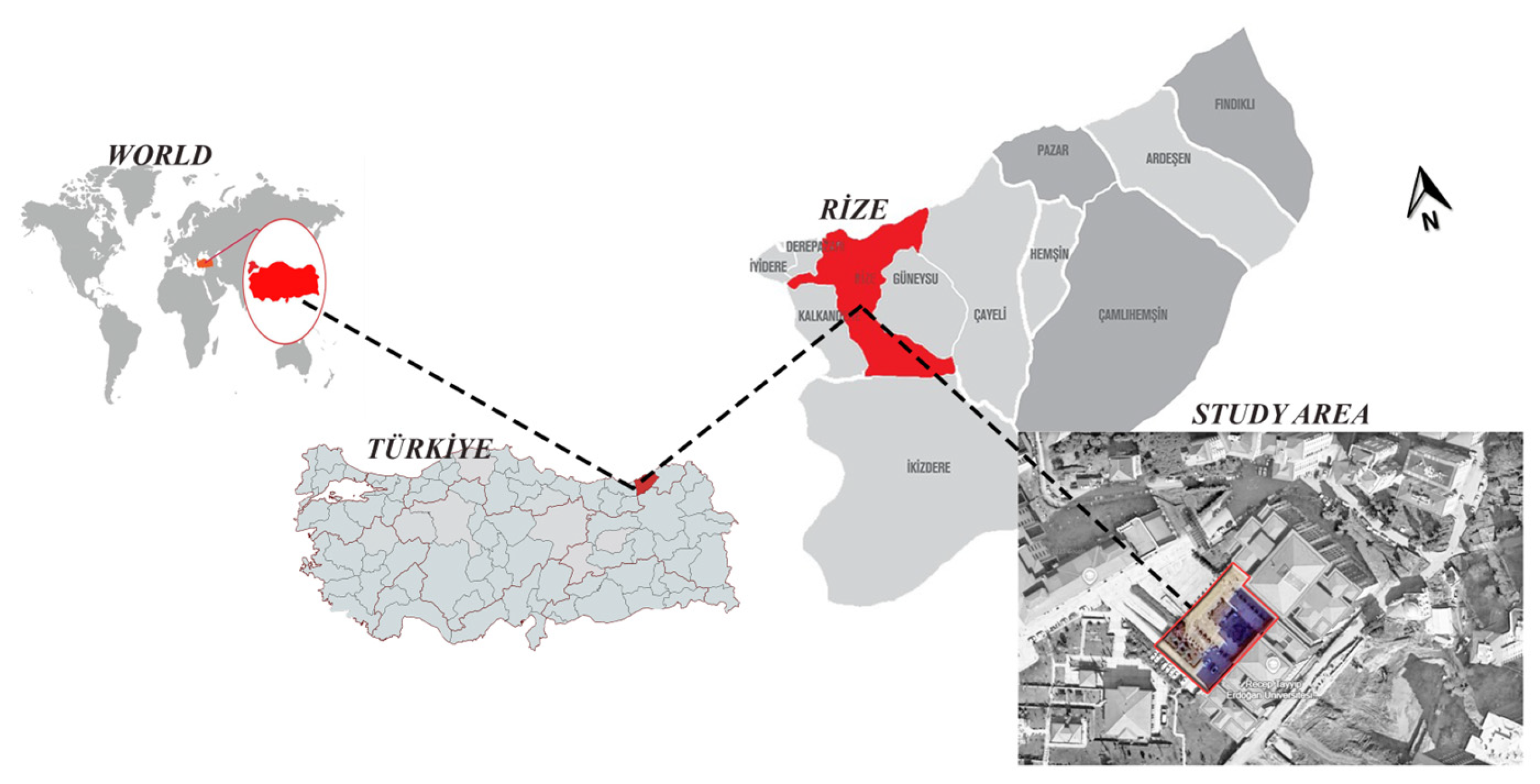

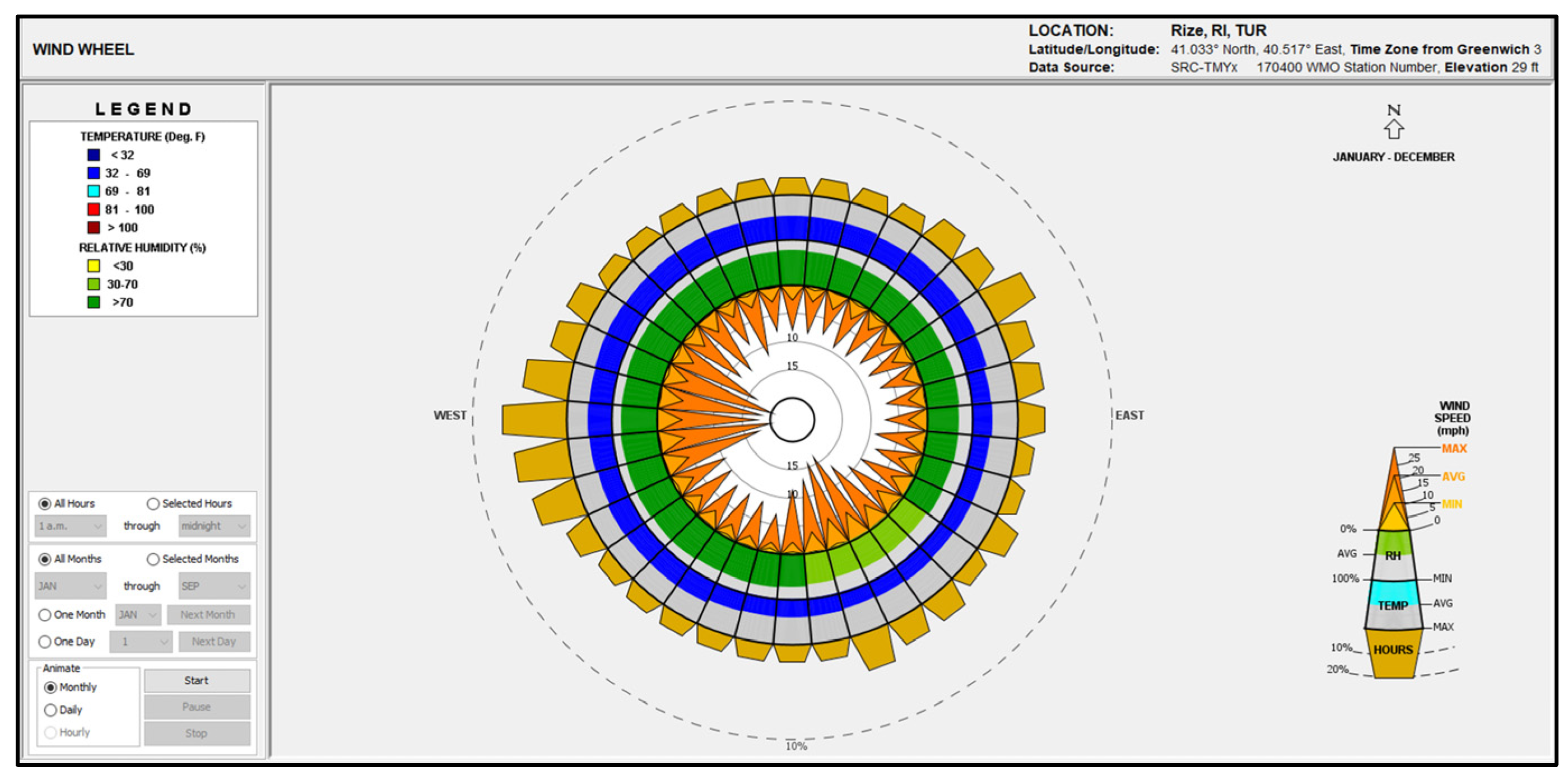

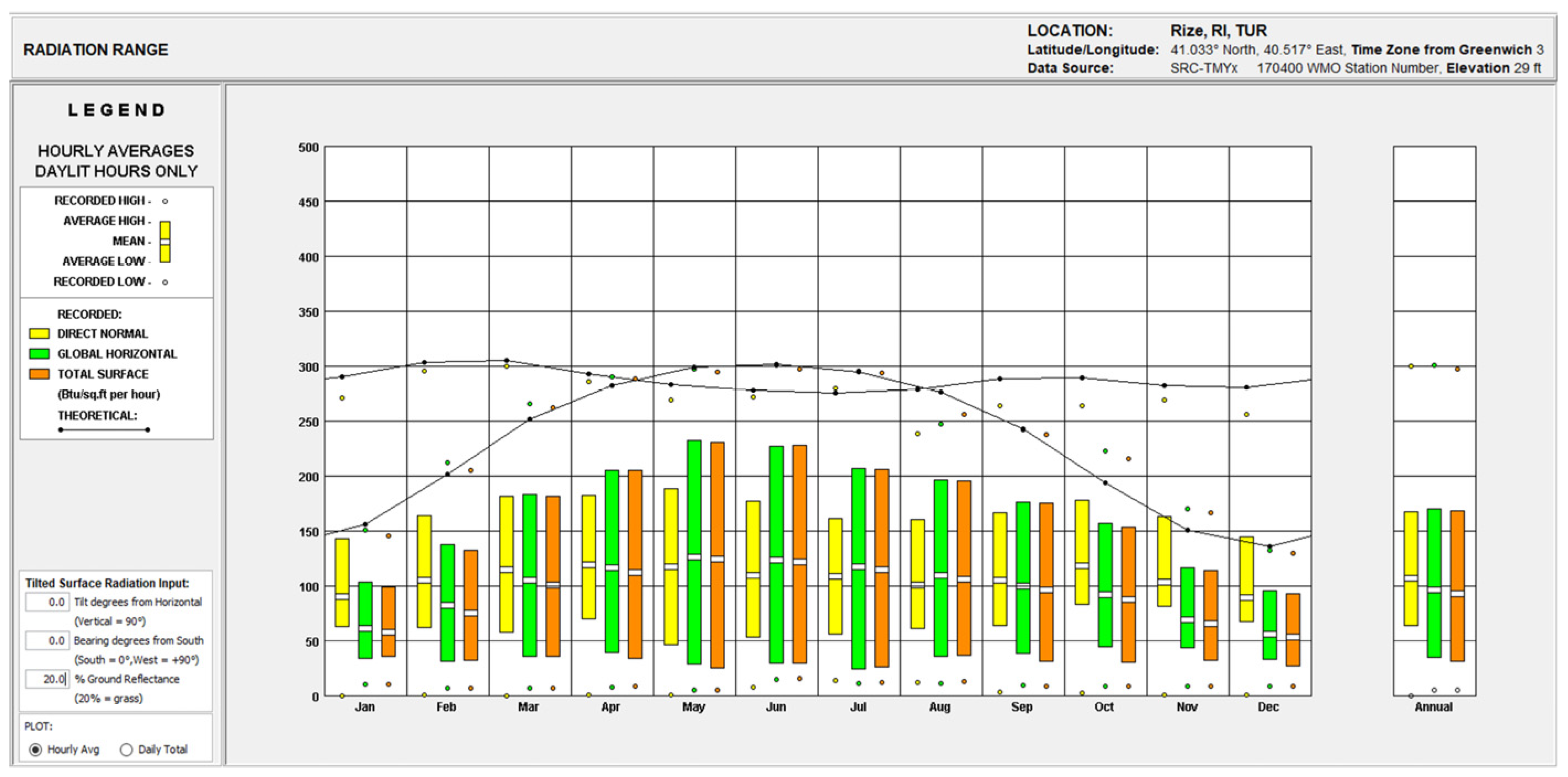

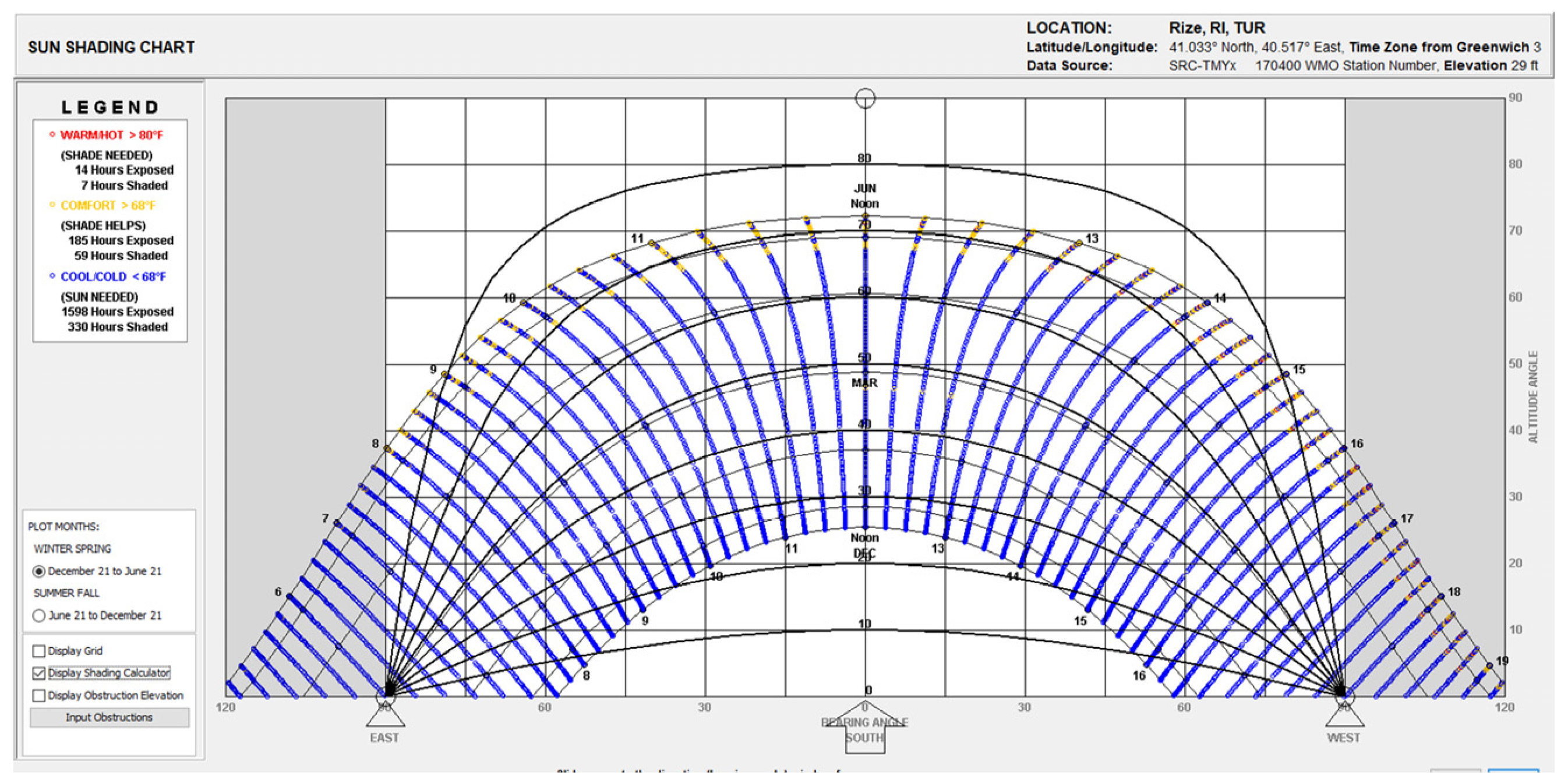
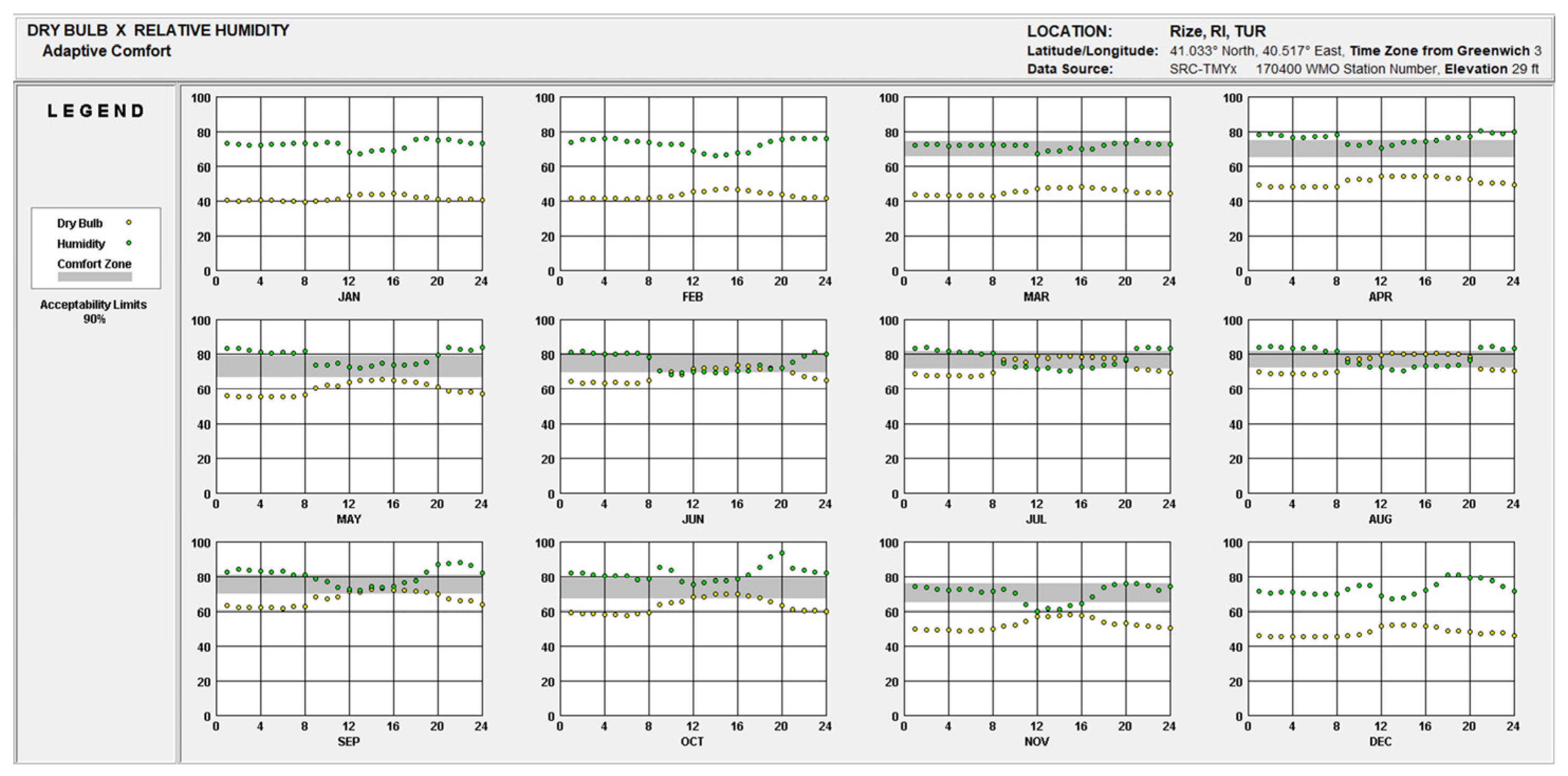

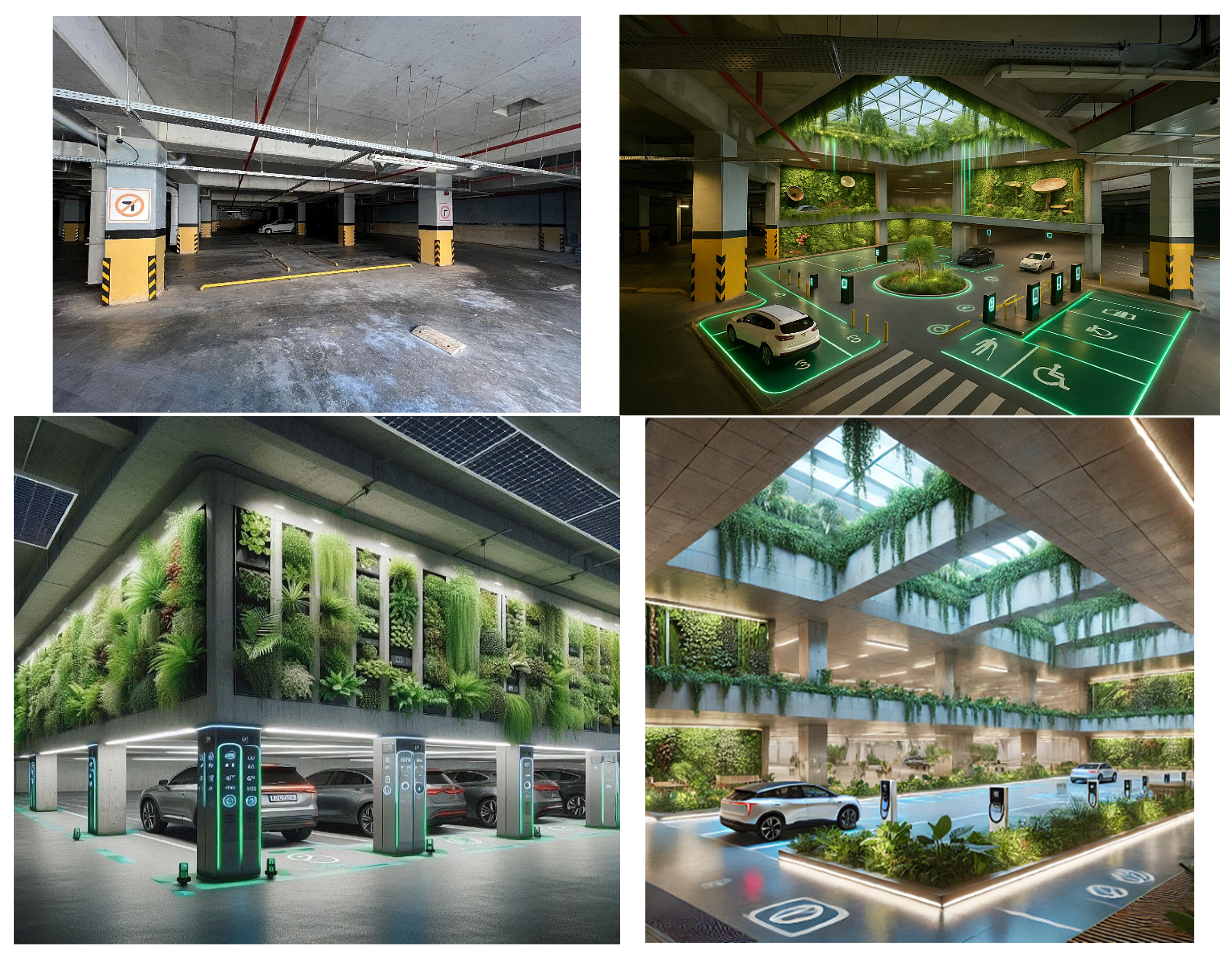

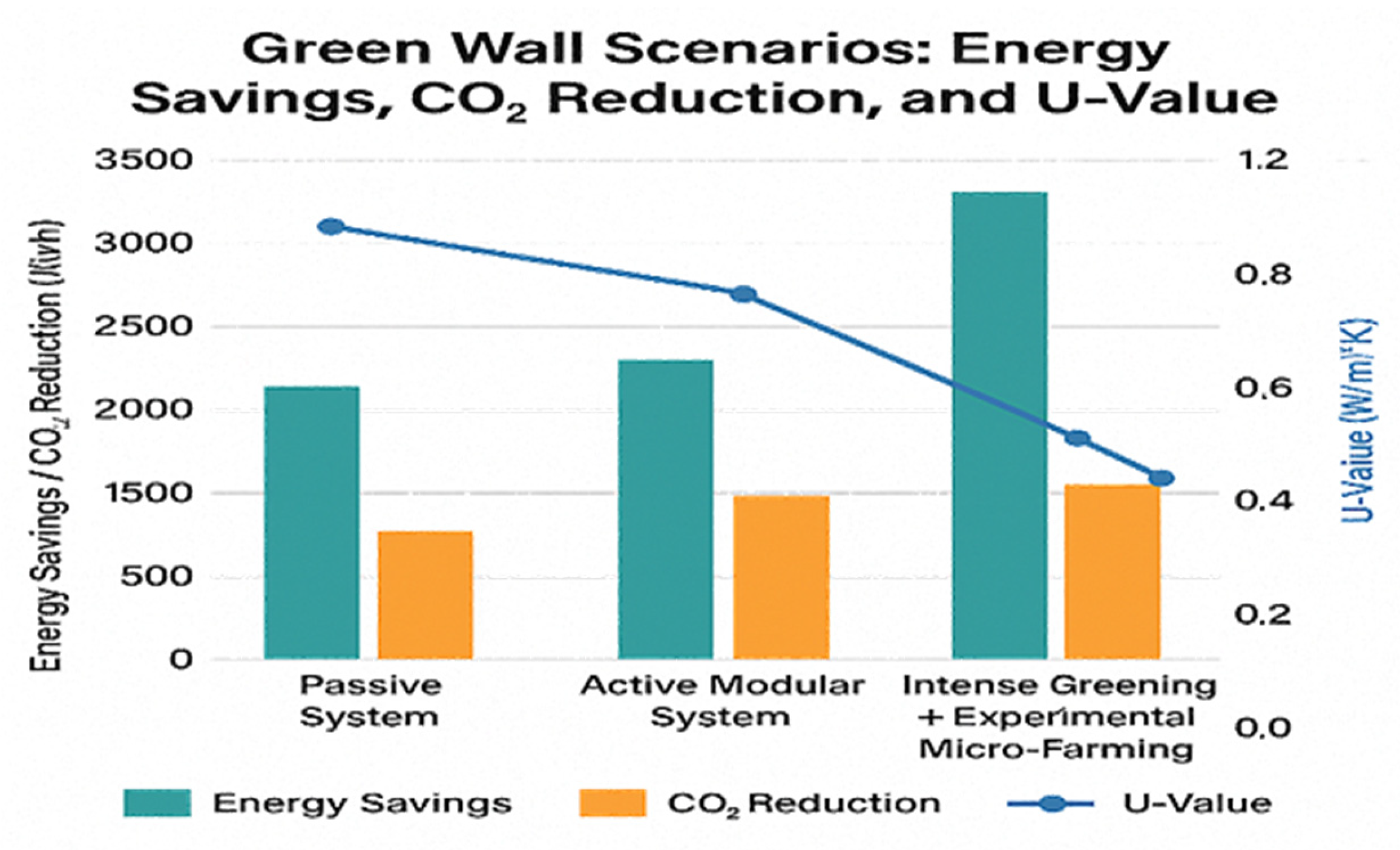
| Ikon | Design Component | Description | Technological Infrastructure | Functional Role/ Area of Use |
|---|---|---|---|---|
 | Vertical Gardens | Planted vertical panels integrated into the interior surfaces of the building | Automatic irrigation, root sensors, photosynthetic LED systems | Improves air quality, provides visual integrity, enhances the biophilic experience |
 | Green Walls | Plant tissue attached to the wall with artificial or natural support systems | Moisture sensors, drip irrigation systems | Contributes to thermal insulation, sound absorption and visual aesthetics |
 | Plant Module | Portable and interchangeable plant containers | Self-watering containers, humidity control sensors | Flexible design, adaptability to seasonal change, ease of maintenance |
 | Floor Lighting | Low energy consumption light systems integrated into walkways | LED light bands, motion sensors | Routing, security, night use |
 | Greywater Recycling System | Treatment and reuse of wastewater for irrigation purposes | Gray water recovery, smart irrigation systems | Saves water, creates sustainable cycle |
 | Hydroponic Module | Vertical or horizontal plant systems working with hydroponics | Nutrient solution pumping systems, automatic light/water balance | Space savings, controlled production and low maintenance |
 | Natural Light Dome | Domed openings or fiber tubes that transmit light through the surface | Light tubes, glass floor panels | Allows sunlight to reach underground, reducing energy consumption |
 | Urban Seating Unit | Seating elements integrated into the structure, integrated with nature | Acoustic panels, modular furniture | Provides spaces for social interaction and allows users to relax |
 | Guiding LED Strip | Linear light elements embedded in the ground | LED strips, timers, motion sensors | Strengthens orientation, security and spatial perception |
| Vegetable Material/Species Group | Area of Use/Purpose | Ecological Demand | Placement Format | Rationale for Eligibility |
|---|---|---|---|---|
| Shade-Tolerant Indoor Plants | Improving air quality, creating a biophilic effect | Low light, moderate humidity, low maintenance | Planters, modular vertical wall panels | Able to photosynthesize in low light, providing visually dense leaf texture |
| Epiphytic Plants | Aesthetic and artistic accent on wall and ceiling surfaces | Ambient humidity is sufficient, no soil needed | Hanging systems, glued natural surfaces | Can survive hydroponics, used on top surfaces with the advantage of low weight |
| Moss Panels/Moss Walls | Acoustic insulation, aesthetics, creating a natural atmosphere in the interior | High humidity, constant temperature, low light | Vertical surface modules | No irrigation, low biological maintenance, sound absorbing |
| Hydroponic Plant Systems | Production in a controlled environment, sustainable food production | Support with nutrient solution, artificial light requirement | Raised systems, vertical agricultural walls | Hydroponic production possible, enabling integration of urban agriculture |
| Bioluminescent Plants/Fungi | Natural lighting, atmosphere creation | Controlled temperature, humid environment | Vertical surfaces, niche areas | Provides light production, aesthetic and experiential value |
| Creeping Groundcovers | Soft transitions on the ground, natural landscape effect | Humid environment, low light | Micro-elevations, ecological islands | Creates a natural surface effect, covers the soil, low maintenance |
| Dwarf Species of Bamboo/C. Lucky Bamboo | Modular plant areas, creating a focal point | Medium light, constant humidity, can be supplemented with artificial light | Large pot groupings, linear placement | Provides structural uprightness, directs light upwards |
| Fern Species (Ferns) | Filtering toxins in the air, balancing humidity | High humidity, shade, good drainage | Wall systems, modular surfaces | Contributes to indoor air quality, provides visually full green texture |
| Criteria | Scenario 1: Passive System | Scenario 2: Active Modular | Scenario 3: Intensive Agriculture |
|---|---|---|---|
| U-Value (W/m2K) | 0.96 | 0.78 | 0.66 |
| Energy Savings (kWh/year) | 1.400 | 2.450 | 3.150 |
| CO2 Reduction (kg/year) | 560 | 980 | 1.260 |
| Plant Species Diversity | Middle | High | Highest |
| Cost | Low | Middle | High |
| Maintenance Requirement | Less | Middle | High |
| User Experience Impact | Middle | High | Highest |
| Scenario | New U-Value (W/m2K) | Energy Savings (kWh/year) | CO2 Reduction (kg/year) |
|---|---|---|---|
| Passive Green Wall (20% improvement) | 0.96 | 1.400 | 560 |
| Active Modular System (35%) | 0.78 | 2.450 | 980 |
| Intensive Planting (45%) | 0.66 | 3.150 | 1.260 |
| Scenario | U-Value (W/m2K) | 6 Monthly Heat Loss (kWh) |
|---|---|---|
| Passive Green Wall (20% improvement) | 0.96 | 40.908 kWh |
| Active System (35% improvement) | 0.78 | 33.237 kWh |
| Intensive Planting (45% improvement) | 0.66 | 28.124 kWh |
| System | Total Installation Cost (₺) | Annual Energy Gain (₺) | Return Period (years) |
|---|---|---|---|
| Passive Green Wall | 540.000 ₺ | 4.200 ₺ | 128 years |
| Active Modular System | 600.000 ₺ | 7.350 ₺ | 81 years |
| Moss Panel | 110.000 ₺ | 1.200 ₺ | 91 years |
| Solar Panel (Total) | 160.000 ₺ | 15.000 ₺ | 11 years |
Disclaimer/Publisher’s Note: The statements, opinions and data contained in all publications are solely those of the individual author(s) and contributor(s) and not of MDPI and/or the editor(s). MDPI and/or the editor(s) disclaim responsibility for any injury to people or property resulting from any ideas, methods, instructions or products referred to in the content. |
© 2025 by the authors. Licensee MDPI, Basel, Switzerland. This article is an open access article distributed under the terms and conditions of the Creative Commons Attribution (CC BY) license (https://creativecommons.org/licenses/by/4.0/).
Share and Cite
Aytatlı, B.; Bayram, S.; İsmailoğlu, S. Deepening Layers of Urban Space: A Scenario-Based Approach with Artificial Intelligence for the Effective and Sustainable Use of Underground Parking Structures. Sustainability 2025, 17, 9397. https://doi.org/10.3390/su17219397
Aytatlı B, Bayram S, İsmailoğlu S. Deepening Layers of Urban Space: A Scenario-Based Approach with Artificial Intelligence for the Effective and Sustainable Use of Underground Parking Structures. Sustainability. 2025; 17(21):9397. https://doi.org/10.3390/su17219397
Chicago/Turabian StyleAytatlı, Başak, Selcan Bayram, and Semiha İsmailoğlu. 2025. "Deepening Layers of Urban Space: A Scenario-Based Approach with Artificial Intelligence for the Effective and Sustainable Use of Underground Parking Structures" Sustainability 17, no. 21: 9397. https://doi.org/10.3390/su17219397
APA StyleAytatlı, B., Bayram, S., & İsmailoğlu, S. (2025). Deepening Layers of Urban Space: A Scenario-Based Approach with Artificial Intelligence for the Effective and Sustainable Use of Underground Parking Structures. Sustainability, 17(21), 9397. https://doi.org/10.3390/su17219397








